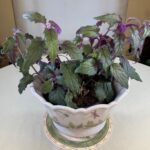How to Water Your Houseplants |
|
Though pests and diseases seem likely culprits, the truth is: Improper watering is the reason why most plants don’t make it. Damage from incorrect watering is common and runs the gamut — from wilting and collapse to drowning. Plants that survive despite watering mishaps often fail to thrive. Results of overwatering houseplantsHow plants fare when faced with incorrect watering varies from utter collapse at the first sign of drought to an eventual weak growth pattern if the abuse continues. Generally, thin-leaved plants are quicker to show symptoms of water damage. Thicker-leaved plants, like succulents, can go longer between waterings. When to water houseplantsWhen to water your plants will vary according to a variety of factors. Every home environment is different, and plant watering needs differ by species. There are, however, some guidelines to keep in mind. Know your plant’s watering requirements. Research your plant and see how much water it needs. Some plants, such as African violets, like to be kept moist, while others, like cactus, prefer drying out between waterings. Most plants like to be watered when they’re just approaching dryness. Pay close attention and you will learn to recognize the signals that each of your plants gives when it needs watering. For instance, many plants “flag” when they’re thirsty, getting a dull sheen to their leaves and wilting slightly. Consider containers and soil mixtures. Smaller containers will dry out more readily than larger ones. Plastic pots stay moist much longer than porous terra cotta. Heavy soil mixes hold more water than light mixes or bark. Check drainage. It is imperative that water doesn’t accumulate at the bottom of the pot because your plant is likely to drown or develop fungal problems that will lead to root rot. Water should readily flow through the pot. Water according to plant needs. Putting your plants on a watering schedule may seem like a good idea, but it’s best if you water only when they actually need it. Always check a plant before watering, even if it is wilting, as droopy leaves are also an indication of overwatering. If the soil is moist, withhold water. There are three methods of checking a plant for watering readiness. Stick your finger in the soil up to your first knuckle. Water if the soil is dry. You can also use a moisture meter — a pronged instrument you stick in the soil that indicates when a plant needs watering. The “pick-up” test can also be a good indicator Elevate the plant pot, if possible. A lightweight container often means it’s time to water. Pay special attention to large containers, as the top of the pot may be dry, while the bottom is very wet, or vice versa. Consider time of year when watering your indoor gardenPlants dry out more quickly during spring and summer months, whereas water consumption slows considerably during cooler times of the year. Heating and air-conditioning systems can also dry plants. Plants close to vents are likely to dry out quickly. How to water houseplants properlyMost plants do best if watered from above. When possible, bring the plant to the sink and let the water run through the pot until the container is heavy with moisture. If a plant has been allowed to dry out too much, this may mean running water through it at a slow pace several times before the soil becomes saturated. Exceptions to the above watering method for indoor plantsAfrican violets, the piggyback plant and other plants with soft, fuzzy leaves are an exception to the top watering rule. Water them from below to avoid foliage water spots, fungal disease and crown rot. This method should also be used to rehydrate plants that have become very dry and whose soil has shrunk away from the sides of the pot. To bottom water, set the pot in a container of water that is slightly bigger. Water will be drawn into the dry soil. Avoid leaving houseplants sitting in waterAvoid leaving plants in water. Houseplants should not sit in water more than 30 minutes. Use a turkey baster or an old sponge to remove water from saucers of large floor plants. Setting large floor plants on a saucer filled with pebbles or marbles is helpful, as it keeps water from contacting the bottom of the pot and humidifies the surrounding air. Water temperature for houseplantsUse tepid to warm water. Studies have shown that cold water causes root damage and leaf spotting. |



